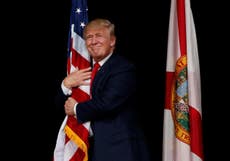What the Russian Revolution can teach us about the Middle East today
The Bolshevik demonisation of the ‘White’ Russians in the ferocious anti-religious, anti-capitalist posters on display in Paris at the Musee de l’Armee are not dissimilar to the “war against terror” which Bashar al-Assad and the Russians think they are fighting in Syria today


These days, uprisings should be studied with a cold eye and there’s a fine little exhibition on in Paris about the 1917 Russian revolution which casts a dark reflection on the Arab “awakening” we’ve all been observing in the Middle East. It’s an extraordinary display from the “revolution which changed the world”, including posters, photographs and – amazingly – some documents which show just how much the Mencheviks (and the Russian Provisional Government) and then the Bolsheviks tried to enlist the Muslim world – and the Armenians – in their destruction of the Romanov dynasty.
I suppose the overthrow of Mubarak (the Tsar) and then the brief 11-month tenure of Mohamed Morsi (representing the temporary Mensheviks comes to mind; but Field Marshal-President al-Sissi of Egypt hardly counts as a Lenin (or a Stalin) and the war which the Egyptian government is now fighting in Sinai bears no relation to the “Whites” versus the “Reds” – yet. On balance, the end of King Farouq of Egypt, the temporary leadership of General Neguib (the Mensheviks) and then the takeover by Nasser would be much closer to the mark.
But Syria is a worrying parallel since it demonstrates just how easily revolution can turn into civil war. The casualty figures don’t come anywhere close to the millions of Russians who were killed in the conflict after 1917, but there are some disturbing features which both conflicts share. The Syrians could scarcely have known how swiftly their war would come upon them. Nor did the Russians in 1917. And the interference of foreign nations – Russia on the side of the Syrian government, America and Britain on the side of the rebels (the “Whites”, until they turned out to be Muslim “Greens”), inserting their troops into Syria with minimum losses since they would let others do the dying – is a painful reminder of what happens when overseas powers decide that they will decide who wins the war.
The British landed at Murmansk to support the “White” Russians, and it’s intriguing to see how the “Whites” set up their own mini-capitals wherever they went – just as Isis set up its capitals in Raqqa – and in Mosul in Iraq. The parallels are not exact, of course, but the Bolshevik demonisation of the “White” Russians in the ferocious anti-religious, anti-capitalist posters on display in Paris at the Musee de l’Armee (the exhibition is called “Et 1917 devient Revolution”) are not dissimilar to the “war against terror” which Bashar al-Assad and the Russians (and the Hezbollah, and the Iranians) think they are fighting in Syria today. There are terrifying cartoons of mass killings, naked men beaten with whips and women led away for rape. Pretty much standard Isis fare.
There are, too, ten-ruble banknotes from the short-lived “commisariat of Transcaucasia”, printed in Russian on one side and in the Armenian, Georgian, and Azeri languages on the reverse. Azeri was in those days written in Arabic script and so it appears on the note. More interesting is a large poster in the Tartar language (printed in 1919 in both Arabic script and in Cyrillic) depicting a horsemen leading a band of warriors and holding a red flag bearing a half moon and a star. “To Muslim comrades,” it announces, “the enemies of the working people are crushing your freedom and you alone can defend your lands, only Soviet power will give you …your mountains… Join the Muslim cavalry regiments…All under the red star.”
I’m not sure what the Tartar Muslims thought of their half-moon under the Red Star of Bolshevism but there are photographs of soldiers in a Muslim village in eastern Anatolia paying homage to the earlier 1905 Russian revolution and a bright snapshot of Red Cross nurse Nino Djordjadze mounted on a camel. Her name is Georgian but she was born in Tiflis (now Tbilisi) in Georgia.
For the Muslim republics of the future Soviet Union – and for the short-lived Armenian republic – there would, of course, be no freedom and Soviet power brought them the same purges and executions as the rest of the USSR which inherited the Russian empire. The Communists tended to feel more at home with the Christian than the Muslim religion, because – so an ex-Soviet citizen told me – Jesus was the son of a working class carpenter while the Prophet Mohamed was a bourgeois businessman. Nowadays, Russia has been busy killing Muslim fighters (“terrorists”) in Syria, some of them descendants, no doubt, of the Tartar horseman supposedly carrying that red flag 98 years ago.

